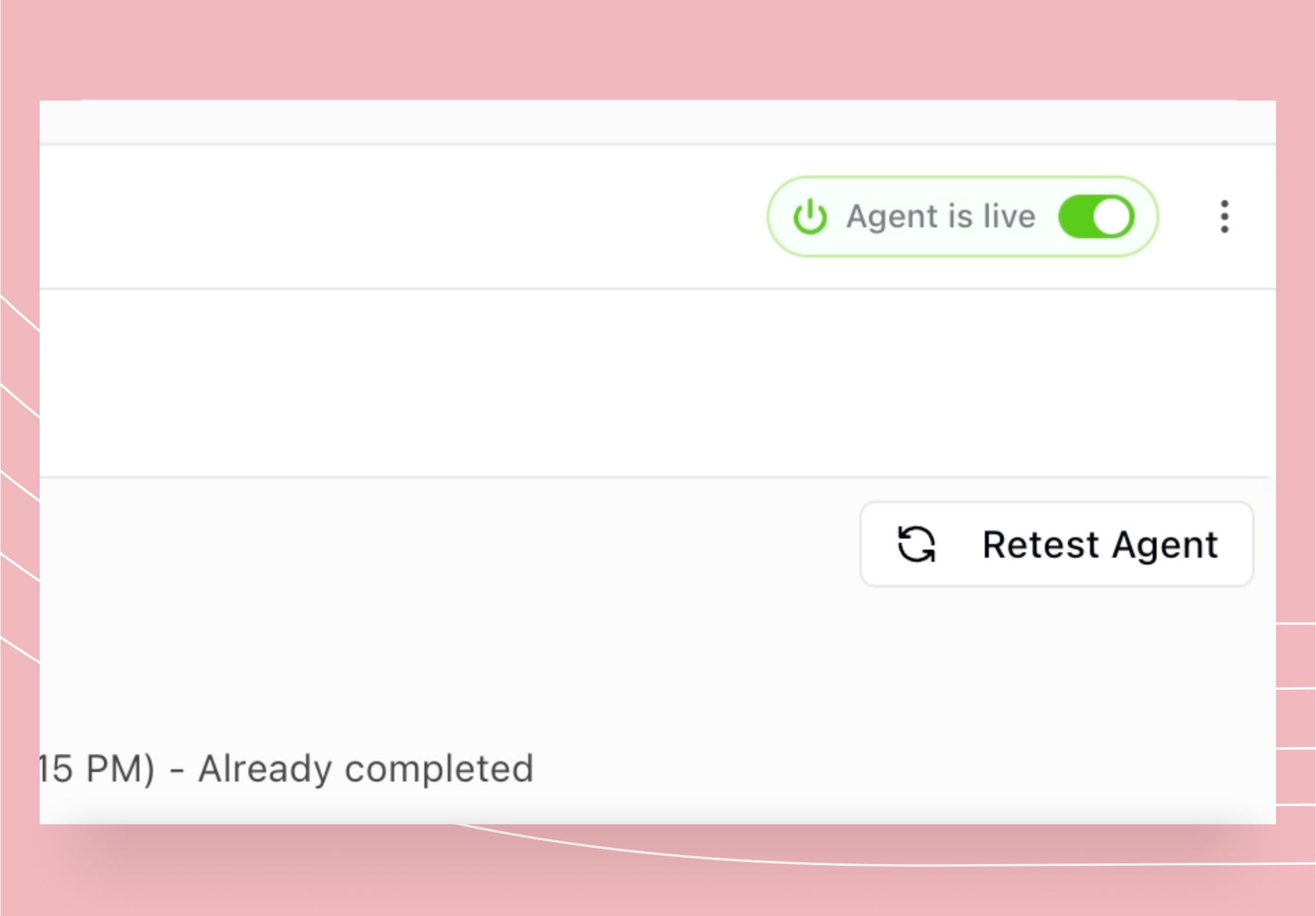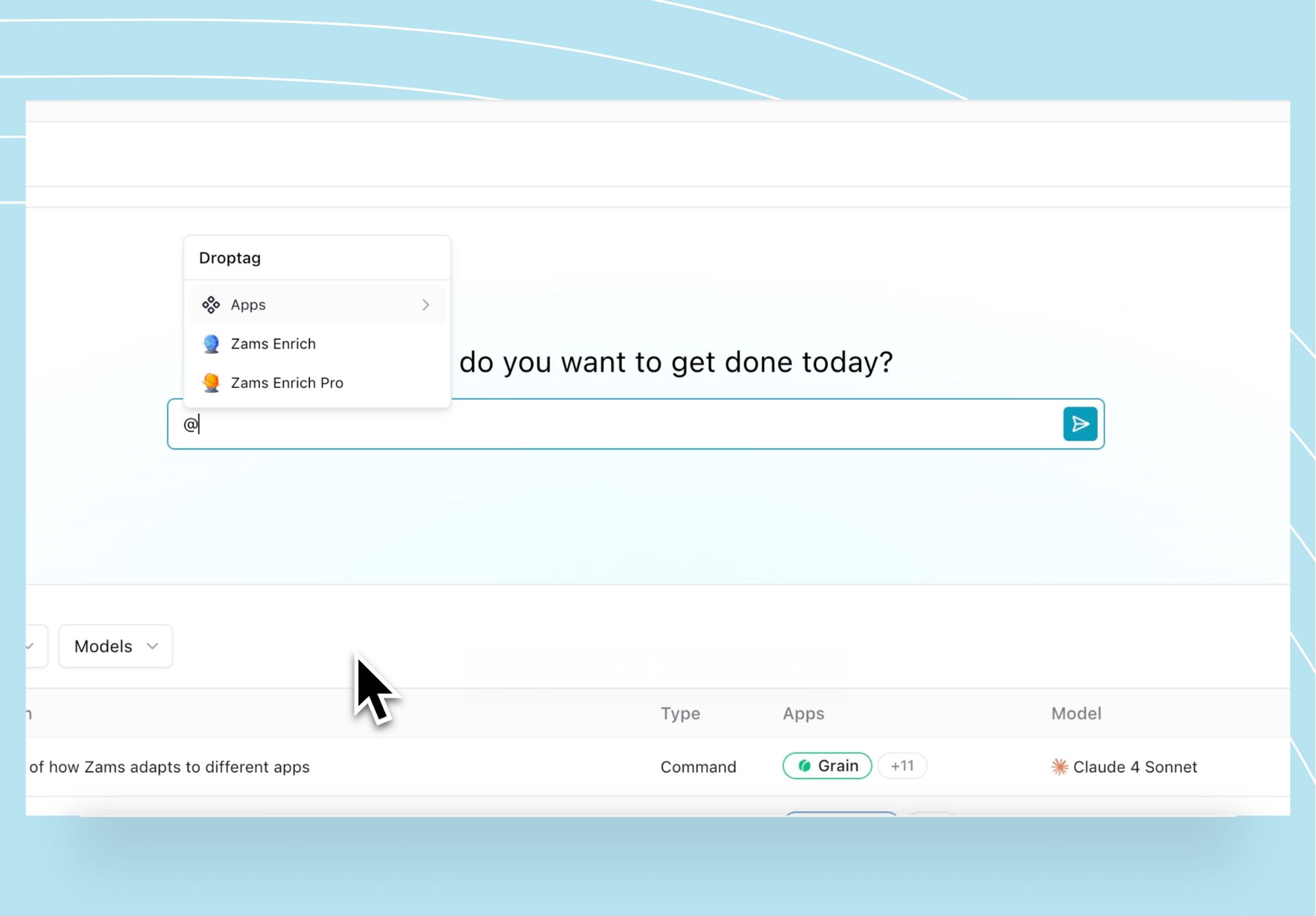Thinking of building an AI agent? Great. But let’s make sure it’s actually useful.
If you’ve been following the rise of agentic AI in 2025, you’ve probably seen the buzz.
“Autonomous agents.”
“Multi-agent ecosystems.”
“Workflows that run themselves.”
It all sounds too futuristic, until you see real businesses using it to get ahead. And they’re doing it without massive engineering teams.
In this post, we’ll unpack how to build agentic AI that works in the real world, focusing specifically on agentic architecture.
Zams is the AI command center for sales. It connects Salesforce, HubSpot, Slack, and 100+ tools - one system, zero friction.
Here’s what we’ll go through:
- Practical agent architectures for different use cases
- Multi-agent designs that scale across teams
- Pro tips to keep your agents reliable and efficient
- Prompting patterns that improve performance
- RAG-based structures to make your agents context-aware
Let’s dive in.
Why does agentic architecture matter?
Unlike a chatbot bolted onto your website, agentic AI is about building autonomous systems that act on your behalf.
These AI-powered agents don’t just answer questions, they:
✅ Break down complex tasks and execute step-by-step
✅ Call APIs, connect with external tools, and plug into your systems
✅ Track context and learn over time
✅ Interact with both humans and other AI agents
They aren’t just interfaces, they’re autonomous actors.
And when you need those specialized agents to collaborate, especially across teams, systems, and data sources, you need orchestration. That’s where agentic architecture comes in. It’s the backbone that allows different agents, models, and tools to cooperate toward shared goals.
Instead of isolated bots or scripts, you get a cohesive multi-agent system that runs reliably in dynamic environments and scales with your business.
Think of it less as “a bunch of AI helpers,” and more like a smart, modular machine with coordination baked in, which comes from the orchestration layer.
On that note, to understand AI orchestration deeply, you might want to read this one 👇

Without orchestration and solid architecture, agents can fall into loops, produce low-quality results, or become opaque systems no one can debug.
With that base, let’s now explore what agentic architecture looks like in practice.
Building blocks: Single-agent architectures
A single-agent architecture means one agent handles the task from start to finish, no delegation, just autonomy.
This model works best for workflows that are clearly defined, repetitive, and don’t require collaboration. Single-agent systems are ideal for simple tasks but may struggle with complex workflows or dynamic environments where multiple AI agents could better distribute responsibilities.
1. Agent + Integrated tools
This is the simplest setup where one agent is connected to your tools (email, CRM, calendar, etc). It automates tasks such as booking meetings, logging updates in your CRM or sending follow-ups automatically, needing no human input. It’s a way to automate repetitive tasks, like a smart behind-the-scenes assistant across your software stack. Large language models and structured data can enhance these single-agent systems by enabling richer analysis and decision-making without multiple agents.
2. Agent triggered from multi-channel platforms
In this set up, the agent usually gets triggered from Slack, Teams, or a web interface to kick off a specific task. Zams, being the multi-agent orchestration platform, takes care of the rest, whether it’s routing the request, handling permissions, or plugging into your CRM, Jira, or internal APIs - all in one clean flow.
It’s a perfect setup for enterprises that care about audit trails, security, and having a consistent way to manage agent-driven automation across multiple entry points.
3. Agent with a routing layer
Sometimes you need logic to drive the flow. That’s where a router comes in, to let the agent branch based on conditions. For example, if someone logs an issue, the agent can decide whether it goes to the legal team or finance based on the request type.
This approach creates a structured workflow for multi-agent systems, enabling scalable, agentic AI systems that remain flexible as business rules change. It’s a clean way to separate decisions, handle complexity, and maintain dynamic environments with minimal friction.
4. Agents with human-in-the-loop
When tasks involve risk or compliance, like approvals or sensitive communications, it's smart to pause the workflow for human review. For example, the agent might draft a contract update and wait for someone to check it on Slack before moving forward.
Once approved, the flow continues. This setup balances automation with human oversight, making sure high-stakes actions stay reliable, traceable, and in line with company policies without adding too much friction.
5. Agent with specialized (modular) sub-agents
This setup is all about scaling without losing focus. A main AI agent hands off specific tasks to smaller, specialized sub-agents - like one for finance, another for support, maybe one for IT.
Each especialized agent is built for a purpose, so you avoid bloated, hard-to-manage agents. It’s a clean way to grow your agentic systems as different teams and use cases come into play, without things getting messy or overly complex. Modern AI-powered agents excel at analyzing data and executing complex tasks across teams, making this setup ideal for large-scale operations.
Scaling up with multi-agent architectures
Multi-agent architectures let multiple agents work in sync or on their own to handle bigger, more complex workflows. Instead of putting all the pressure on one all-knowing agent, each agent plays to its strengths.

They team up to solve problems that are too broad or dynamic for a single agent to manage well. Multi-agent systems excel in these scenarios, enabling agentic AI systems to operate effectively in dynamic environments where adaptability and collaboration matter. For businesses, this means more flexibility. You can automate complex tasks across teams, like cross-functional approvals or syncing real-time structured data between systems.
Now, let’s look at some examples of multi agent architectures.
1. Sequential agents
This setup connects agents in a clear, step-by-step flow. One AI agent finishes its task and passes it along to the next, like a relay.
It’s a great fit for processes with multiple steps, like onboarding, detailed approvals, or compliance reviews. You get structure and reliability without slowing things down, making sure nothing important gets missed along the way.
2. Parallel agents with shared tools
In a parallel agent setup, multiple AI agents work at the same time, each focused on a specific task while using shared external tools like a central ticketing or messaging system.
This approach speeds things up and makes collaboration smoother, especially in high-volume use cases like sending customer updates or managing internal requests where both speed and coordination are key. It’s a strong example of agentic architecture in action, showing how modern AI agents can handle analyzing data and orchestrating tasks simultaneously across multiple domains.
3. Tiered agents + shared RAG
In this model, agents are organized in layers, each accessing specialized knowledge bases or databases, often using Retrieval-Augmented Generation (RAG) combined with large language models. They gather and combine information to deliver thorough and well-rounded results.
This approach works really well for customer support, in-depth research, or internal Q&A, where pulling together varied, trusted insights helps provide quicker and more precise answers.
If you’re curious, exploring how agentic RAG functions could be your next step.

3 types agentic architectures with RAG
Now that you're familiar with how RAG helps AI agents tap into proprietary or specialized external knowledge such as docs, wikis, or internal databases, let’s walk through a few agentic AI architectures that integrate RAG into agentic AI systems.
1. Embedded RAG in a Single Agent
Here, one agent handles it all. It queries the knowledge source (like a vector DB or internal wiki), grabs the right context, and replies accordingly. This single agent architecture is super handy for functions like product support, onboarding questions, or how-to guides, or basically anywhere you want to offer accurate, source-backed responses.
2. Multi-agent parallel RAG
In this setup, multiple agents can independently search different data sources in parallel and then pool what they find. It’s a smart way to speed up processing across domains or teams.
For instance, Creditt used Zams in this exact approach to predict loan repayment, eliminating 208 days of backlog and accelerating approval processes at scale. This demonstrates the real-world power of modern AI agents working together, each a specialized agent focused on a specific slice of the problem, to deliver faster, more accurate results than a traditional single agent system could achieve alone.

3. RAG + Human review
For high-stakes use cases like compliance, legal, or anything that really needs to be right, you can add a human-in-the-loop step to your RAG workflows.
The agent does the heavy lifting by pulling and summarizing the info, but a human gives it a final review before it goes out. It’s a great way to reduce risk and build trust, especially in sensitive environments.
Ready to build enterprise-grade agents? Here are a few quick tips to keep in mind.
Architecture tips to build stable, reliable agents
- Use memory intentionally – Let agents store and retrieve short- or long-term context
- Think in loops – Break large jobs into smaller, repeatable steps
- Be explicit with tools – Don’t assume agents know how your systems work
- Plan before executing – Force agents to reason through tasks before they start
- Insert human reviews – Especially where quality or compliance matters
- Expect failure modes – Build retry and fallback logic into your flows
- Craft clear prompts – Precision in inputs = quality in outputs
- Test with real workflows – You'll catch edge cases faster
- Document everything – With Zams, your flows are visual, traceable, and easy to debug
Better prompts = better agents
Prompt engineering is part of your architecture. It guides your agent’s planning, reasoning, and decision-making.
Here’s what makes a prompt effective:
- Set a clear goal
- Break down the task
- Add constraints or rules
- Provide useful background
- Include good/bad examples
- Ask the agent to reflect before answering
- Show the structure of an ideal output
- Use roles or personas to frame the context
- Limit scope where necessary
- Iterate based on test results
Try it with Zams
Zams is a multi-agent orchestration platform built for teams that want to deploy agentic systems fast, without wrangling infrastructure or fine-tuning models.
Just define your objective and write a context prompt. Zams does the rest, including handling routing, integrations, memory, error management, and versioning.
Want to try it on your ops, finance, or customer workflows?
Parting thoughts
Agentic architecture is not about flashy demos or novelty use cases. It’s a new way of thinking about business automation - flexible, modular, and smart.
You still need strong design, good prompting, and real-world testing. That’s what separates shiny tools from real impact.
Zams helps you bridge that gap, from idea to reliable execution.
Start with one agent. Learn. Scale.
And if you found this useful? Share it with someone building the future too.
FAQ
1. What is agentic architecture, and why does it matter?
Agentic architecture is the backbone that allows autonomous AI systems to operate seamlessly across tools, teams, and data sources. It goes beyond basic chatbots by enabling modern AI agents to break down complex tasks, call APIs, track context, and interact with both humans and other agents. This kind of agentic AI architecture orchestrates how multiple AI agents and specialized agents work together in dynamic environments to execute complex workflows reliably. The result is scalable, intelligent automation that turns AI models into real-world business impact.
2. What's the difference between single-agent and multi agent systems?
Single-agent systems rely on one AI agent to handle a task end to end. They’re well suited for repetitive, clearly defined processes where the same logic applies every time.Multi agent systems, on the other hand, coordinate multiple agents to collaborate on larger, more complex workflows. This approach is ideal when tasks need to be distributed, specialized, or run in parallel, for example, when different agent systems handle data enrichment, decision-making, and execution separately. In these cases, multi-agent architectures deliver higher speed, adaptability, and efficiency, especially in dynamic environments.
3. What are some practical use cases for agentic AI?
Agentic AI systems are built to handle everything from simple automations to highly complex tasks. A single agent can automate actions like booking meetings, logging CRM updates, or generating reports. But multi-agent systems can manage far more sophisticated workflows, such as coordinating specialized agents for sales operations, orchestrating external tools for data enrichment, or even analyzing structured data from multiple sources before triggering actions.
This makes agentic AI a powerful solution for cross-functional approvals, high-volume data processing, and customer support powered by RAG-based knowledge retrieval.
4. How does RAG (Retrieval-Augmented Generation) improve AI agents?
RAG lets AI-powered agents retrieve and reason over knowledge from databases, wikis, or APIs, making their responses more accurate and source-backed. For example, an agent can combine structured data from a CRM with unstructured insights from documentation to provide richer answers. In multi agent systems, one agent might specialize in retrieval while another focuses on reasoning, creating a more powerful agentic AI system that’s capable of deeper context and better decision-making in dynamic environments.
5. How does Zams help with building agentic AI systems?
Zams is a multi-agent orchestration platform designed to make building agentic AI systems straightforward and scalable. It handles routing, memory, error management, and integration with external tools, so teams can deploy multiple AI agents without heavy engineering lift.By unifying single agent and multi-agent architectures, Zams helps companies design agentic AI that can automate complex workflows, collaborate across systems, and adapt to changing conditions. It’s how organizations turn AI models into production-ready, autonomous AI systems built for real business outcomes.



